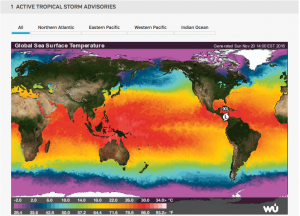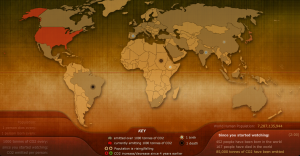Weather Underground (https://www.wunderground.com/hurricane/atlantic/2016/Invest-90L?map=model), a weather forecasting website, has many different options for tracking weather systems around the world. The platform that stood out most to me was a global map that tracks hurricanes, tropical cyclones, and all active tropical storm advisories. This global map shows areas of low pressure and global sea surface temperatures. There is also satellite imagery and details of the specific storm activity in the North Atlantic, East Pacific, Western Pacific, Central Pacific, and Indian Ocean.
The most interesting part of Weather Underground is the archive that they have of past hurricanes and tropical storms. All previous storms year by year are listed and the maximum winds and minimum pressure are listed. For all previous storms you are also able to track them on a map of the ocean they occurred in.
Below is a picture of the active tropical storm advisories for Sunday, November 20th. We are able to see one low pressure area around South America.


